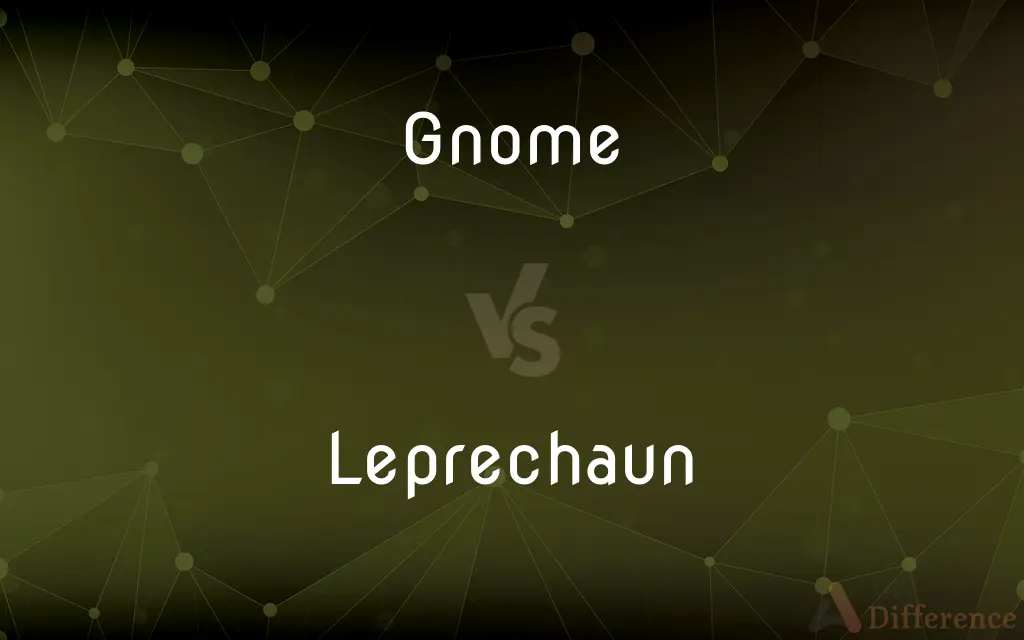Gnome vs. Leprechaun — What's the Difference?
By Maham Liaqat & Fiza Rafique — Updated on March 25, 2024
Gnomes are mythical creatures associated with the earth and protection, whereas leprechauns are Irish fairies known for mischief and guarding treasure.

Difference Between Gnome and Leprechaun
Table of Contents
ADVERTISEMENT
Key Differences
Gnomes are depicted as small, elderly beings, often with long beards and pointed hats, who live underground and guard the earth's treasures. They are considered protective spirits of the earth and minerals. Leprechauns, on the other hand, are a type of fairy in Irish folklore, characterized by their small size, green attire, and solitary nature. They are primarily known for their trickery, especially in protecting their pots of gold.
While gnomes have been portrayed in various mythologies and stories as benevolent and shy, avoiding human contact and living in harmony with nature, leprechauns are often depicted as cunning and enjoy outsmarting humans. Gnomes are said to be helpful, tending to wildlife and the environment, whereas leprechauns are more self-serving, their interactions with humans usually revolving around their own protection or amusement.
In terms of origin, gnomes have roots in Renaissance magic and alchemy, symbolizing the earth element. Their lore has been enriched over the centuries in various European cultures. Leprechauns, however, are distinctly Irish, with their legends deeply embedded in Celtic mythology. They are often associated with the Tuatha Dé Danann, a race of divine beings in Irish myth.
Gnomes are commonly featured in modern gardens as statues, symbolizing good luck and protection. This tradition contrasts with the leprechaun's presence in popular culture, where they are often linked to St. Patrick's Day and represented as cheerful, if mischievous, characters chasing rainbows or brewing ale.
The physical appearance of these creatures also differs significantly. Gnomes are typically shown wearing simple, earth-toned clothes and pointy hats, reflecting their connection to the ground. Leprechauns are immediately recognizable by their green coats, hats, and buckled shoes, embodying the vibrant spirit of Irish folklore.
ADVERTISEMENT
Comparison Chart
Origin
European mythology
Irish folklore
Nature
Benevolent, protective
Mischievous, elusive
Appearance
Elderly, long beards, pointed hats
Small, green attire, buckled shoes
Association
Earth, minerals, nature protection
Pots of gold, rainbows, trickery
Cultural Symbolism
Garden statues, protection
St. Patrick's Day, Irish culture
Compare with Definitions
Gnome
A mythical creature said to guard the earth's treasures underground.
He placed a statue of a gnome in his garden for good luck.
Leprechaun
Symbol of Irish folklore and St. Patrick's Day.
Leprechauns are often featured in St. Patrick's Day parades.
Gnome
Associated with gardening and nature.
Each gnome in the garden represented a different aspect of nature.
Leprechaun
An Irish fairy known for mischief and guarding gold.
The leprechaun hid his pot of gold at the rainbow’s end.
Gnome
Represents earth element in alchemy.
In his study, the alchemist referred to gnomes as guardians of the earth element.
Leprechaun
Distinguished by their green attire and trickery.
In the tale, the leprechaun outsmarted the traveler with a clever trick.
Gnome
A symbol of protection and good fortune in folklore.
The gnome figurine was passed down as a family heirloom.
Leprechaun
Associated with cobbling and rainbows.
The leprechaun was also a skilled cobbler, making shoes for other fairies.
Gnome
Often depicted with a pointed hat and beard.
The story described a wise gnome with a deep blue hat.
Leprechaun
Known for their solitary nature.
Unlike other fairies, the leprechaun preferred to live alone, away from human eyes.
Gnome
A gnome is a mythological creature and diminutive spirit in Renaissance magic and alchemy, first introduced by Paracelsus in the 16th century and later adopted by more recent authors including those of modern fantasy literature. Its characteristics have been reinterpreted to suit the needs of various story tellers, but it is typically said to be a small humanoid that lives underground.Diminutive statues of gnomes introduced as lawn ornaments during the 19th century grew in popularity during the 20th century and came to be known as garden gnomes.
Leprechaun
A leprechaun (Irish: leipreachán/luchorpán) is a diminutive supernatural being in Irish folklore, classed by some as a type of solitary fairy. They are usually depicted as little bearded men, wearing a coat and hat, who partake in mischief.
Gnome
One of a fabled race of dwarflike creatures who live underground and guard treasure hoards.
Leprechaun
In Irish folklore, a mischievous elflike creature or fairy who grants wishes or reveals the location of hidden treasure when captured.
Gnome
In the occult philosophy of Paracelsus, a being that has earth as its element.
Leprechaun
(Irish folklore) One of a race of elves that can reveal hidden treasure to those who catch them.
Gnome
A pithy saying that expresses a general truth or fundamental principle; an aphorism.
Leprechaun
A small mischevous elf or spirit in Irish folklore; it is often depicted in literature as a dwarfish bearded old man; - legend tells that if a leprechaun is captured, he will reveal the location of his hidden pot of gold.
Gnome
A brief reflection or maxim; a pithy saying.
Leprechaun
A mischievous elf in Irish folklore
Gnome
An elemental (spirit or corporeal creature associated with a classical element) associated with earth.
Gnome
One of a race of imaginary human-like beings, usually depicted as short and typically bearded males, who inhabit the inner parts of the earth and act as guardians of mines, mineral treasure, etc.; in modern fantasy literature and games, when distinguished from dwarves, gnomes are usually even smaller than dwarves and more focussed on engineering than mining.
Gnome
A person of small stature or misshapen features, or of strange appearance.
Gnome
The northern pygmy owl, Glaucidium gnoma, a small owl of the western United States.
Gnome
A small statue of a dwarf-like character, often bearded, placed in a garden.
Gnome
An upper atmospheric optical phenomenon associated with thunderstorms, a compact blue starter.
Gnome
A banker, especially a secretive international one.
The gnomes of Zurich
Gnome
An imaginary being, supposed by the Rosicrucians to inhabit the inner parts of the earth, and to be the guardian of mines, quarries, etc.
Gnome
A dwarf; a goblin; a person of small stature or misshapen features, or of strange appearance.
Gnome
A small owl (Glaucidium gnoma) of the Western United States.
Gnome
A brief reflection or maxim.
Gnome
A legendary creature resembling a tiny old man; lives in the depths of the earth and guards buried treasure
Gnome
A short pithy saying expressing a general truth
Common Curiosities
Do gnomes and leprechauns interact with humans?
Leprechauns may interact more with humans, usually in tricky or mischievous ways, while gnomes are typically shy and avoid human contact.
Where do gnomes and leprechauns originate from?
Gnomes have origins in European mythology, whereas leprechauns are specific to Irish folklore.
What do gnomes and leprechauns symbolize?
Gnomes symbolize protection and good fortune, especially related to nature and the earth. Leprechauns symbolize the playful and mischievous spirit of Irish culture.
What is the primary difference between gnomes and leprechauns?
Gnomes are associated with the earth and its protection, while leprechauns are known for their mischief and guarding treasures.
How are gnomes and leprechauns typically portrayed in modern culture?
Gnomes are often depicted as garden statues or in children's stories, while leprechauns are linked to St. Patrick's Day and appear in various forms of media as cheerful, tricky characters.
Can gnomes and leprechauns be considered the same type of creature?
No, they have distinct origins, characteristics, and roles in folklore.
How do gnomes and leprechauns differ in their interactions with the natural world?
Gnomes are protectors of nature and wildlife, while leprechauns do not have a specific role in the natural world beyond their association with rainbows.
Are gnomes or leprechauns considered good luck?
Both can be considered symbols of good luck, but in different contexts.
What is the significance of a leprechaun's pot of gold?
It symbolizes wealth and the elusive nature of leprechauns, often tied to the challenge of catching one to claim his treasure.
What do gnomes wear?
They typically wear simple, earth-toned clothes with pointed hats.
Why do leprechauns wear green?
Green is associated with Ireland and Irish folklore, symbolizing the lush landscapes and cultural traditions.
Are there female gnomes and leprechauns?
Folklore mentions both, but they are less commonly depicted in popular culture.
What are leprechauns known for?
They are known for their trickery, especially related to their hidden pots of gold.
Can gnomes be found in gardens?
Yes, gnome statues are popular garden decorations, believed to bring good luck and protect the garden.
Do gnomes have any magical abilities?
Yes, gnomes are often attributed with various magical abilities related to their protective role over the earth and nature.
Share Your Discovery

Previous Comparison
Worder vs. Worker
Next Comparison
Nucleobase vs. NucleosideAuthor Spotlight
Written by
Maham LiaqatCo-written by
Fiza RafiqueFiza Rafique is a skilled content writer at AskDifference.com, where she meticulously refines and enhances written pieces. Drawing from her vast editorial expertise, Fiza ensures clarity, accuracy, and precision in every article. Passionate about language, she continually seeks to elevate the quality of content for readers worldwide.















































